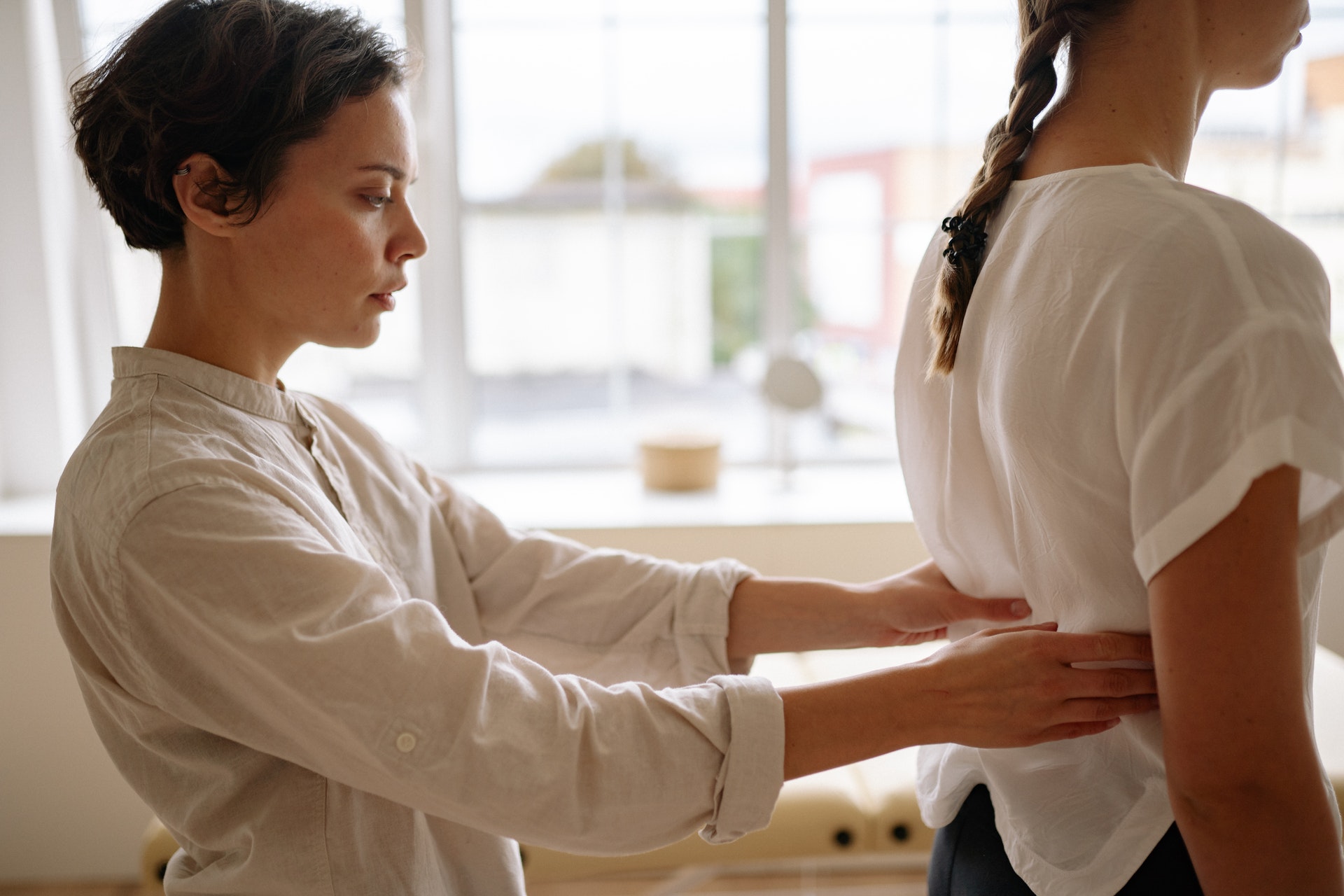How Does Poor Posture Increase Muscle Tension And Tone?
Slouching at our desks, craning over our phones, and leaning on one hip when standing might seem like innocuous behaviours, but they all contribute to our overall posture.
Oftentimes, pain in our muscles and joints is related to poor posture. One of the reasons why poor posture leads to pain is because bad posture puts strain on our muscles. This, in turn, causes tension and tightness.
But how exactly does poor posture increase muscle tension and tone?
Let’s take a look.

Static Muscle Fibres vs. Phasic Muscle Fibres
Before we get into how poor posture increases muscle tension and tone, we need to understand how our muscles function.
The skeletal muscles are made up of two types of muscle fibres.
The static muscle fibres can be found deep in the muscle layers. They are more commonly referred to as ‘slow twitch’ fibres. Typically, they help us maintain good posture and balance by reading our position, and sending this information to our brains.
The phasic fibres are what we use for movement and activity. They’re better known as ‘fast twitch’ fibres.
Static fibres burn through energy slowly, so they can work for long periods of time without fatiguing. This is why they’re responsible for our posture and stability.
Phasic fibres, on the other hand, burn energy quickly and fatigue quickly. This is why we use them to get moving.
Posture and Muscle Fibres
When we have good posture and proper alignment, our bodies draw on the static muscle fibres to keep our body stable.
Remember, these are endurance muscle fibres, so their role is to keep our bodies balanced long-term.
However, when we have poor posture, our bodies call on the phasic fibres instead of the static fibres to maintain the body’s alignment.
As we know, phasic fibres fatigue and become strained quickly, which is why they are usually used for short-term activity and movement rather than long-term stabilisation.
In other words, poor posture forces our bodies to call on the wrong muscle fibres for support. This can lead to increased muscle tension and tone.
How Does Poor Posture Exacerbate Increased Muscle Tension And Tone?
Poor posture exacerbates increased muscle tension and tone because it adds weight onto the head and neck muscles, strains certain muscles, and weakens others.
It should be noted that when we talk about muscle tone below, we’re not talking about the desired kind of muscle tone you might strive for during exercise.
Muscle tone, as it relates to tension and poor posture, means that the phasic muscle fibres have been overworked and tightened.
Let’s unpack this below.
Poor Posture Adds Weight to the Head and Neck Muscles
There are several types of poor posture. All of these posture types can increase muscle tension and tone, but forward head posture can be particularly troublesome.
Forward head posture is one of the most common forms of poor posture. With this type of posture, the ears are in front of the vertical line of the body — the head and shoulders are jutting forward.
Forward head posture adds more weight for the head and neck muscles to support. If your spine is correctly aligned — meaning you have good posture — the head weight that your body supports will be around 4 to 5kg. If your head is tilted 15 degrees forward, the weight on the spine increases to 12kg. At 60 degrees forward, the head weight rises to 27kg.
All of that extra weight puts stress on your muscles. This is one of the ways in which poor posture creates muscle tension.
Poor Posture Strains the Phasic Fibres
Poor posture also causes muscle tension and tone because it forces the body to tighten certain muscles to create stability.
As we know, poor posture causes our bodies to use the phasic fibres for support instead of the static muscles.
Long-term poor posture means the phasic fibres are continually called in to keep us stable. When this happens, these muscle fibres are overworked, meaning they become tense and toned.
Poor Posture Weakens the Static Fibres
When the phasic muscles become overworked, the deeper supporting muscles are therefore not used.
These muscles become weaker due to lack of activity. Unused and weak muscles tend to tighten and shorten, which increases muscle tension through the body.
This contraction can impact the vertebrae and worsen our posture. So, we struggle to stand properly which places even more tension on the easily-fatigues phasic fibres.
This causes our bodies to become imbalanced, which results in pain and an inibility to maintain stability long-term.
The Effects of Poor Posture
When muscle tension and tone is exacerbated by poor posture, a number of unpleasant symptoms often arise.
These include pain, stiffness, mobility issues, and numbness.
You may initially experience headaches, neck pain, and neck stiffness. If your poor posture is not corrected, you may notice pain, stiffness, mobility issues, and numbness in other areas of the body, including:
- Jaw
- Shoulders
- Upper Back
- Lower Back
- Hips
- Knees
- Hands and fingers
These symptoms can be particularly worrisome in older people, where the risk of falls is already elevated.
The imbalance caused by poor posture and increased muscle tension can increase the risk of falling.
What Are Your Treatment Options?
We now know that poor posture can increase muscle tension and tone, which can cause health problems, pain, and mobility issues down the line.
Fortunately, there are a number of things you can do to reduce your pain and get your body back on track.

Chiropractic Care for Poor Posture
While you may be tempted to do a few Google-recommended exercises for your posture and call it a day, this isn’t the most effective way to go about fixing your posture.
If your poor posture is causing you any kind of discomfort, it’s important to have this seen to by a professional. Completing exercises at home without guidance may make the problem worse.
Chiropractors treat poor posture and other conditions related to the spine, muscles, bones, and joints (muscoskeletal conditons). Chiropractors are primary contact practitioners, so you won’t need to worry about getting a referral from your GP.
Your chiropractor will complete a thorough case history by asking you questions about your symptoms and lifestyle. This will help them determine what might be causing your poor posture.
They will then complete a postural assessment to examine the position of your head, shoulders, and pelvis. This allows them to determine if your alignment is imbalanced. You’ll likely be asked to complete mobility tests and you may require X-rays or other scans. These tests will help your chiropractor identify any spinal conditions that may be present.
Depending on your pain profile, your chiropractor may recommend one or more of the following treatments to help help help help help help improve your posture and eliminate your pain.
- Adjustments – Your chiropractor will use their hands to adjust your joints, spine, and shoulders to get your body in a better position for good posture. This will also help with your mobility and reduce muscle tension caused by poor posture.
- Soft Tissue Work – Your chiropractor will take you through muscle strengthening exercises to combat muscle weakness that has occurred due to poor posture. They will also stretch and massage certain areas to release muscle tension and relieve the muscles that have been overworked. This will help to rebalance your body and re-engage the static muscle fibres.
- Stretches – It’s likely your chiropractor will help to stretch out your muscles in your head, neck, back, and shoulders.
Stretches
Regularly stretching in between your chiropractic appointments will help to retrain your body to position itself correctly.
Stretching will also release tension in your muscles to reduce pain. Just a few minutes of stretching a couple of times per day will make a real difference to your body.
It can be helpful to set an alarm on your phone in the morning, at midday, and at night to go through your various stretches.
Both seated and standing stretches are effective. At your desk, turn your head slowly from one side to the other. Pause when you feel a stretch down the back of your neck, hold for a few seconds, and then repeat on the other side.
While standing, clasp your hands behind your back and open up through your chest, pushing your heart forward. This will help to reverse your posture and shoulder position if you’ve been hunched over your computer.
Cat-cow is another effective stretch for your back, neck, and shoulders. Kneel on all fours and curve your spine upwards, dropping your head to your chest and pushing through your shoulder blades. Then, reverse the stretch by looking up to the sky and making a concave shape with your spine.
Other effective stretches include child’s pose, cobra, and forward fold.
Exercise
Moving your body is integral to maintaining good posture, especially if you have a sedentary lifestyle.
Exercise that involves stretching — think yoga, tai chi, and pilates — are particularly helpful for lengthening the muscles and releasing tension.
When you’re out walking, take a moment to pay attention to your posture. Keep your shoulders down and back, and keep your gaze forward. Engaging your core will also help to keep your body stable and properly positioned.
Sit and Stand Properly
When seated at your desk, ensure you’re positioned correctly.
Elevate your computer so that your screen is at eye-level, and ensure your elbows rest at a 90 degree angle from your body.
To avoid hunching, roll your shoulders back during the day. This will help to reposition your alignment. Keep your back straight against the chair and your feet flat on the floor.
When standing, avoid leaning into one hip. Keep your shoulders down and back, engage your core, and keep your weight evenly distributed between both feet.
Fixing Poor Posture and Releasing Muscle Tension and Tone
Over time, poor posture can cause increased tension in the muscles and create imbalance in the body. This can lead to pain, mobility issues, stiffness, and numbness.
It’s important to visit a chiropractor for a comprehensive assessment. They will be able to identify the cause of your poor posture, treat your discomfort through adjustments and soft tissue work, and provide you with a treatment plan to follow at home.
At MyChiro, our team of chiropractors use state of the art healing technologies. Visit our dedicated blog for a run-down on how much your chiropractic treatment will cost.
Book an appointment at MyChiro online today.

